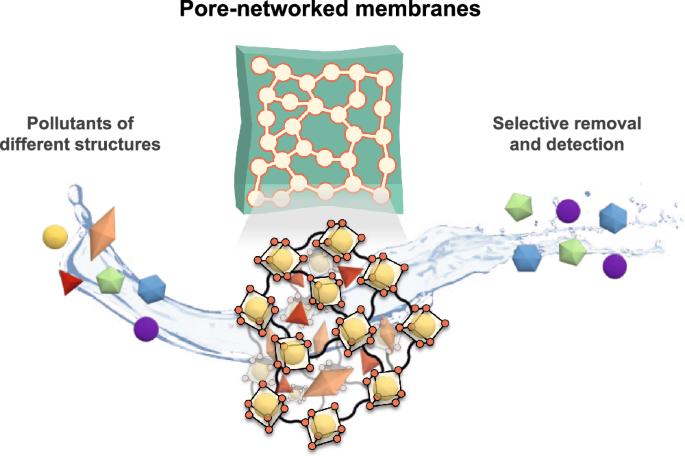Pore-networked membrane using linked metal-organic polyhedra for trace-level pollutant removal and detection in environmental water
IF 9.6
Q1 MATERIALS SCIENCE, MULTIDISCIPLINARY
引用次数: 0
Abstract
The wide presence of pharmaceuticals and personal care products (PPCPs) in water is a major pollution concern even at the part per billion level, which urges their detection and removal. Current research emphasizes the use of microporous materials as adsorbents for pollutant removal but demonstrates the performance at a higher concentration than realistic environmental water due to the absence of efficient detection methods that can be coupled with the removal process. Here we report a pore-networked membrane (PNM) that can simultaneously remove and detect targeted trace-level PPCPs. These PNMs are designed by interconnecting adsorbents within polymer matrices, forming continuous, tunable porous networks that are accessible for PPCPs, thereby offering high selectivity and adsorption capacity. Evaluations across water samples containing 13 pollutants demonstrate the capability of PNMs to selectively adsorb PPCPs for removal and subsequently release them into analysis solution for detection, positioning their promising use in real water treatment workflow. It is challenging for microporous materials to remove pollutants at concentrations relevant to environmental water. Here, a pore-networked membrane system designed from linked metal-organic polyhedra can simultaneously remove and detect targeted pharmaceuticals and personal care products at trace level

利用链接金属有机多面体的孔网络膜去除和检测环境水体中的痕量污染物
药物和个人护理产品(PPCPs)在水中的广泛存在是一个重大的污染问题,即使在十亿分之一的水平上也是如此,因此需要对其进行检测和去除。目前的研究强调使用微孔材料作为吸附剂去除污染物,但由于缺乏可与去除过程相结合的高效检测方法,因此只能在比实际环境用水浓度更高的情况下展示其性能。在此,我们报告了一种可同时去除和检测目标痕量级 PPCPs 的孔网络膜 (PNM)。这种 PNM 的设计方法是在聚合物基质中将吸附剂相互连接,形成可接触 PPCPs 的连续、可调的多孔网络,从而提供高选择性和高吸附能力。对含有 13 种污染物的水样进行的评估表明,PNMs 能够选择性地吸附 PPCPs 以进行去除,并随后将其释放到分析溶液中进行检测,因此在实际水处理工作流程中大有可为。微孔材料要去除与环境水相关浓度的污染物具有挑战性。在这里,由相连的金属有机多面体设计的孔网络膜系统可以同时去除和检测痕量水平的目标药物和个人护理产品。
本文章由计算机程序翻译,如有差异,请以英文原文为准。
求助全文
约1分钟内获得全文
求助全文
来源期刊

Communications Materials
MATERIALS SCIENCE, MULTIDISCIPLINARY-
CiteScore
12.10
自引率
1.30%
发文量
85
审稿时长
17 weeks
期刊介绍:
Communications Materials, a selective open access journal within Nature Portfolio, is dedicated to publishing top-tier research, reviews, and commentary across all facets of materials science. The journal showcases significant advancements in specialized research areas, encompassing both fundamental and applied studies. Serving as an open access option for materials sciences, Communications Materials applies less stringent criteria for impact and significance compared to Nature-branded journals, including Nature Communications.
 求助内容:
求助内容: 应助结果提醒方式:
应助结果提醒方式:


